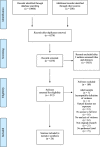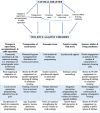The pathways between natural disasters and violence against children: a systematic review
- PMID: 34247619
- PMCID: PMC8273959
- DOI: 10.1186/s12889-021-11252-3
The pathways between natural disasters and violence against children: a systematic review
Abstract
Background: Natural disasters are increasingly affecting a larger segment of the world's population. These highly disruptive events have the potential to produce negative changes in social dynamics and the environment which increase violence against children. We do not currently have a comprehensive understanding of how natural disasters lead to violence against children despite the growing threat to human populations and the importance of violence as a public health issue. The mapping of pathways to violence is critical in designing targeted and evidence-based prevention services for children. We systematically reviewed peer-reviewed articles and grey literature to document the pathways between natural disasters and violence against children and to suggest how this information could be used in the design of future programming.
Methods: We searched 15 bibliographic databases and six grey literature repositories from the earliest date of publication to May 16, 2018. In addition, we solicited grey literature from humanitarian agencies globally that implement child-focused programming after natural disasters. Peer-reviewed articles and grey literature that presented original quantitative or qualitative evidence on how natural disasters led to violence against children were included. The authors synthesized the evidence narratively and used thematic analysis with a constant comparative method to articulate pathways to violence.
Results: We identified 6276 unduplicated publications. Nine peer-reviewed articles and 17 grey literature publications met the inclusion criteria. The literature outlined five pathways between natural disasters and violence, including: (i) environmentally induced changes in supervision, accompaniment, and child separation; (ii) transgression of social norms in post-disaster behavior; (iii) economic stress; (iv) negative coping with stress; and (v) insecure shelter and living conditions.
Conclusions: Service providers would benefit from systematic documentation to a high-quality standard of all possible pathways to violence in tailoring programming after natural disasters. The identified pathways in this review provide a foundation for designing targeted prevention services. In addition, the positive coping strategies within certain affected families and communities can be leveraged in implementing strength-based approaches to violence prevention.
Keywords: Child protection; Children; Emergency; Humanitarian crisis; Natural disaster; Violence.
© 2021. The Author(s).
Conflict of interest statement
The authors declare that they have no competing interests.
Figures
Similar articles
-
Violence against children and natural disasters: A systematic review and meta-analysis of quantitative evidence.PLoS One. 2019 May 30;14(5):e0217719. doi: 10.1371/journal.pone.0217719. eCollection 2019. PLoS One. 2019. PMID: 31145758 Free PMC article.
-
Child Abuse in Natural Disasters and Conflicts: A Systematic Review.Trauma Violence Abuse. 2021 Jan;22(1):176-185. doi: 10.1177/1524838019835973. Epub 2019 Mar 13. Trauma Violence Abuse. 2021. PMID: 30866745
-
Natural hazards, disasters and violence against women and girls: a global mixed-methods systematic review.BMJ Glob Health. 2021 Apr;6(4):e004377. doi: 10.1136/bmjgh-2020-004377. BMJ Glob Health. 2021. PMID: 33958379 Free PMC article.
-
Natural and man-made disasters: the vulnerability of women-headed households and children without families.World Health Stat Q. 1993;46(4):227-33. World Health Stat Q. 1993. PMID: 8017082
-
Experience of Nurses Providing Care at Shelters After Natural Hazards and Disasters: A Qualitative Systematic Review.J Nurs Res. 2025 Apr 1;33(2):e386. doi: 10.1097/jnr.0000000000000671. J Nurs Res. 2025. PMID: 40162698
Cited by
-
Identifying the Preparedness Components for Sexual Violence in Natural Disasters: A Systematic Review.Med J Islam Repub Iran. 2022 Dec 21;36:158. doi: 10.47176/mjiri.36.158. eCollection 2022. Med J Islam Repub Iran. 2022. PMID: 36721492 Free PMC article. Review.
-
Exploring Deeper Causes Linking Adolescents' Mental Disorders to Mobile Phone Use Problems: Grounded Theory Approach.JMIR Form Res. 2022 Feb 21;6(2):e31089. doi: 10.2196/31089. JMIR Form Res. 2022. PMID: 35188470 Free PMC article.
-
Trauma and US Minority Children and Youth.Curr Psychiatry Rep. 2022 Apr;24(4):285-295. doi: 10.1007/s11920-022-01336-1. Epub 2022 Mar 14. Curr Psychiatry Rep. 2022. PMID: 35286562 Free PMC article. Review.
-
Interventions addressing impacts of climate change on sexual and reproductive health and rights in sub-Saharan Africa: A scoping review.PLoS One. 2025 Aug 11;20(8):e0329201. doi: 10.1371/journal.pone.0329201. eCollection 2025. PLoS One. 2025. PMID: 40788888 Free PMC article.
References
-
- Centre for Research on the Epidemiology of Disasters. Natural disasters 2017: Centre for Research on the Epidemiology of Disasters; 2018. https://cred.be/sites/default/files/adsr_2017.pdf. Accessed 21 Apr 2021
-
- United Nations Children’s Fund. Annual Report 2017: United Nations Children’s Fund; 2018. www.unicef.org/publications. Accessed 27 Jan 2019
-
- International Displacement Monitoring Centre. Global report on internal displacement - GRID 2017. Int Displace Monit Centre. 2017; http://www.internal-displacement.org/global-report/grid2017/pdfs/2017-GR.... Accessed 4 Apr 2018.
-
- Brown O. The numbers game. Forced Migr Rev. 2008;31:8–9.
Publication types
MeSH terms
LinkOut - more resources
Full Text Sources
Medical
Miscellaneous



